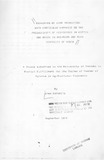| dc.contributor.author | Ziwa, E | |
| dc.date.accessioned | 2013-05-27T06:05:50Z | |
| dc.date.available | 2013-05-27T06:05:50Z | |
| dc.date.issued | 1979-09 | |
| dc.identifier.citation | Degree of Master of Science in Agricultural Economics | en |
| dc.identifier.uri | http://erepository.uonbi.ac.ke:8080/xmlui/handle/123456789/25987 | |
| dc.description | A Thesis submitted to the University of Nairobi in
Partial Fulfillment for the Degree of Master of
Science in Agricultural Economics | en |
| dc.description.abstract | Crop losses caused by pests, diseases and
weeds is known to be high all over the world
especially in the developirg countries. In Kerya,
cotton crop is attacked by many pests and the
damage is considered serious in most of the growing
areas. Maize crop too is attacked mainly by maize
stalk borers. The problem in many parts of Kenya
is that farmers are reluctant to use pesticides to
control these pests. One of the reasons why they
are unwilling to use pesticides is that they are
not sure of the productivity of pesticides.
The objective; of this case study is to
estimate production elasticities for various inputs
and then estimate the marginal value product ofpesticidss on
cotton in Machakos and Meru Districts. Marginal
productivity of chemical pesticides for maize in
Meru District will also be estimated. Another
objective of the study is to find out whether the
productivity of pesticides on cotton in Machakos
will differ from the productivity of pesticides
on cotton in Meru District. The two Districts
have different average rainfall. In addition to
productivity. the study will try to.find out
whether there is a si[nificant difference between
the yield per hectare of maize sprayed with
pssticides and the yield per hectare of maize
sprayed with pesticides in Meru District.
Literature review revealed that there is
very little hardwork done on the productivity of pesticides in Africa.
The study was carriea out at Mbiuni location
in Machakos District and Lower Abothuguchi
location in Meru District. Secondary data collected
by the Ministry of Agriculture were used. A. large
sample of farmers was used and these farmers were
participating in the Integrated Agricultural
Development programme which w es initiated in
1976/77 for development of small scale farmers.
The farmers get credit facilities for the inouts
supplied to them and pay back after harvest.
Supply of inputs and payment of loans is done
through local co-operative societies. The data
used, covered the long rain season of 1977.
Analysis of the data was done using a
Cobb Douglas response function and a regression
analysis was carried out. Ihe dependent variable
for cotton and maize was yield in kilogram. The
independent variables used v:ere: (1) land in
hectares. (ii) expenditure on p8stiCidos in Kenya
shillings. (iii) weeding labour in man-days. (iv)
other labour in man-days, (v) quantity of seeds in
xix -
Kg .• (vi) expenditure on fertilizers in Kenya
shillings.
Results showed that chemical pesticides
had a positive marbinal value product especially
on cotton at average farm level. In Machakos
District. the rarginal value product of pesticides
on cotton was K.Shs 1.05 and in Meru District it
was K.Shs 1.53 per one Kenya Shilling. The marginal
value product of pesticides on maize in Meru
District was K.Shs 3.63 per one Kenya Shilling.
More research. however, is needed on the productivity
of pesticides on maize. | en |
| dc.language.iso | en | en |
| dc.publisher | University of Nairobi | en |
| dc.title | Economics of crop protection: with particular emphasis on the productivity of pesticides on cotton and maize in Machakos and Meru Districts of Kenya | en |
| dc.type | Thesis | en |
| local.publisher | Department of Agricultural Economics | en |

